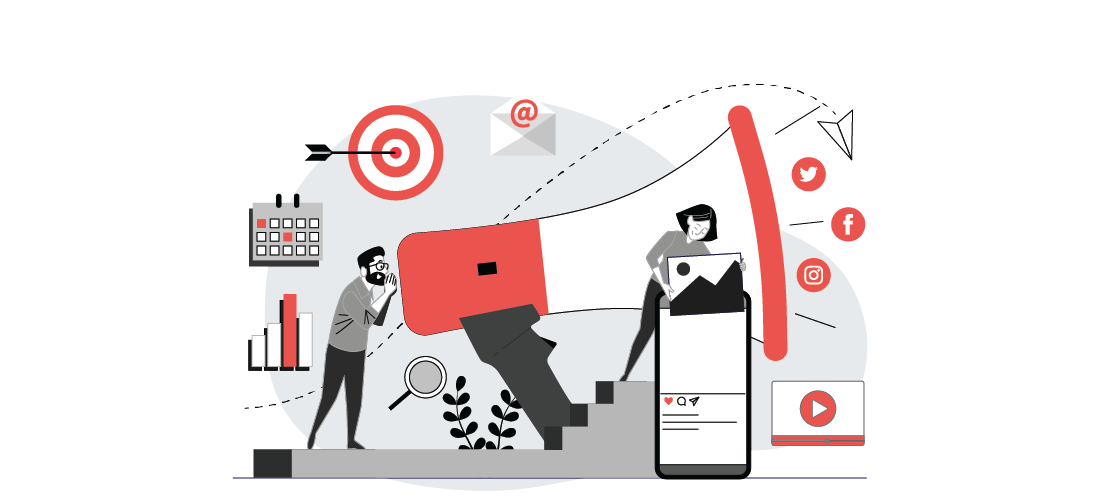In the current world of speed, technology, and digital influence, conventional forms of advertising no longer carry the same weight they did in the past. Non traditional advertising has introduced new and innovative ways brands can be heard, reach their audience, and make a deep impression.
Non traditional advertising is far beyond the classic TV commercials or print ads. Rather, it makes use of more out of the box concepts, for the most part going for online media, influencer collaborations, guerrilla marketing, and interactivity. By diverging from the ordinary and going towards the unexpected, brands have a chance to be heard in a busy market. While companies strive to connect with consumers more authentically and on a deeper level, non traditional advertising is game changing.
In this blog, we will discuss the power of non traditional advertising, various forms it can take, and why it's becoming the preferred method for brands wanting to reach through the clutter. Let's get started!
What is non traditional advertising?
Non traditional advertising means breaking free from the conventional TV commercials, radio spots, and print media. It's a new, innovative strategy that employs out of the box media to reach out to individuals and market products, services, or brands. While traditional advertisement tends to be interruptive, non traditional forms fit right into the fabric of daily life, grabbing eyeballs without disrupting it. Consider social media, viral webisodes, or interactive experiences that invite people in. This form of advertising is all about creating an actual emotional bond with the audience. All the hot techniques such as influencer marketing, guerrilla campaigns, and experiential events are on the rise because they have a more personal, lasting impression. With today's rapid fire, fractured media environment, alternative advertising provides an innovative means by which brands can cut through the clutter and engage with their audience in ways that matter.
Why Choose non-traditional advertising?
Non traditional advertising holds some strong benefits for brands who want to differentiate themselves and engage their listeners in the current packed marketplace. Possibly the greatest benefit is the increased involvement it produces. In comparison to traditional advertisements that simply shout a message, non traditional means engage people in a genuine way, leaving them feeling invested. Whether it's a playful social media viral hashtag or an innovative, interactive pop up event, these campaigns somehow manage to catch people's eyes and create real relationships with people. Another awesome advantage is how cost effective it is. Non traditional methods, such as influencer partnerships or guerrilla marketing, tend to be less expensive, enabling small brands to stand alongside the heavy hitters. This makes non traditional advertising particularly desirable for startups or companies with more limited budgets. In addition, it provides brands with the opportunity to reach hard to reach demographics whether it's niche online communities or younger, technologically connected consumers who are apt to turn off traditional advertising. By deviating from the norm, brands can really differentiate and reach their target audience.
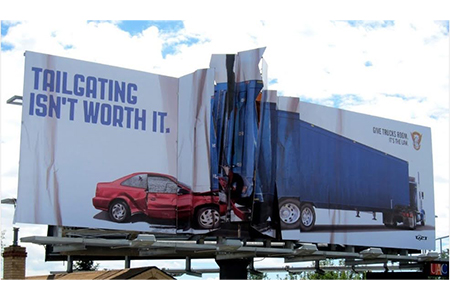
Types of non traditional advertising
Guerrilla marketing
Guerrilla marketing depends on shock value and creativity. The unconventional style involves employing inexpensive, high impact tactics that disrupt the regular rhythms. Flash mobs, innovative billboards or breathtaking street graffiti or guerrilla projection and installation, which surprises consumers at public places off their radar screens, anything is possible. The secret to guerrilla marketing is creating buzz and generating excitement. If done right, it creates buzz that spreads like wildfire. Guerrilla marketing campaigns typically tap into local culture, popular culture, or the news to generate experiences that people will not soon forget. What makes it so powerful is its ability to go viral, generating huge attention without the astronomical expense of traditional advertising. This makes it a go to strategy for brands that must create a strong, long term impression but do not have the budget for big media buys. With creative thinking and thinking outside the box, guerrilla marketing allows brands to be noticed in a way that is fresh and interesting.
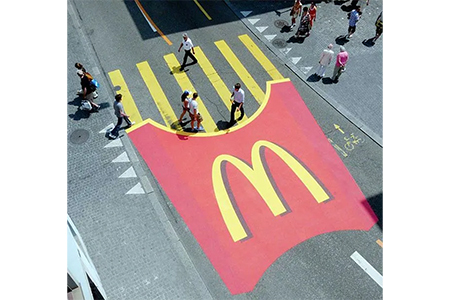
Experiential marketing
Experiential marketing is all about developing memorable experiences that bring customers in and allow them to engage with a brand. From an entertaining pop up store to an in store demo, even an immersive virtual reality experience, these campaigns transcend promoting a product alone, they work towards building a true emotional connection with the customer base. The concept is to make consumers a part of the experience, either in person or online, so that they can have memories that relate to the brand long term. Picture attending an event and being able to visit a trendy interactive display and get hands on with new products, enjoy live demonstrations, and share it on social media. It's an individual experience that will stay with you. This form of marketing doesn't merely inform people, it makes them loyal. When individuals feel that they have experienced an actual connection with a brand, they are much more likely to be customers for the long period of time.
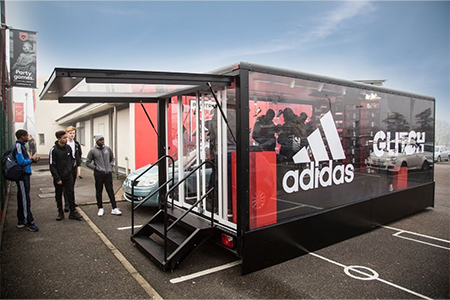
Influencer marketing
With the age of digital times, influencer marketing has become one of the strongest and most effective means of non traditional advertising. Influencers with huge social media followings team up with brands to endorse products or services in an organic and natural way. Influencer marketing is different from traditional celebrity endorsements because it connects with consumers on a more personal level. Influencers prefer discussing products based on experience and recommending based on trust and credibility. This type of advertisement is very useful with young, social media dominant target audiences who find it easier to believe in endorsements from influencers as opposed to classic advertisements. For fashion and beauty on Instagram to tech YouTubers, brands can engage the services of those influencers who possess dedicated fanbases. This opens up brands to highly active niche audiences, and this enhances brand awareness while allowing for greater engagements with prospects.
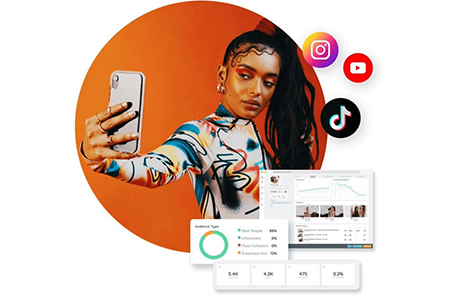
Social media campaigns
Social media campaigns have emerged as the most popular and successful method through which brands connect with their audiences. With an active base of billions on channels such as Instagram, Facebook, and Twitter, brands are now able to engage a global base in a fraction of a second. The greatest strength of social media is that it turns ordinary consumers into possible brand ambassadors. Through something as simple as challenges, contests, or trending hashtags, brands can induce user generated content, achieving a chain reaction effect that drives their message way farther than they might be able to on their own. These campaigns establish communities and offer brands the capability to interact with their audience in real time, gaining immediate feedback and information to improve their products and services. The catch? When social media campaigns are viral, brand awareness is reached organically through shares, likes, and collaborations. By generating content that is not only shareable but also relevant, brands can establish long term relationships and remain engaged with their audience for the longer term.
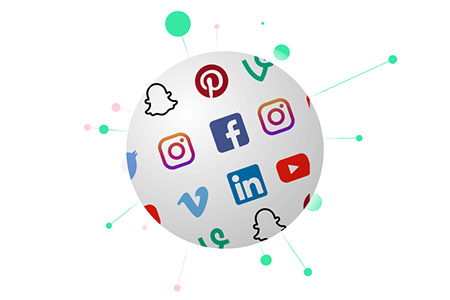
Examples of non traditional advertising in action
Zomato's "Foodie" campaign
Zomato, one of India's food delivery giants, effectively conducted a non conventional ad campaign that appealed to a wide audience. With funny and offbeat billboards and social media updates, Zomato adopted the "foodie culture" by projecting familiar food moments. The brand's cheeky tone and current, pop culture references made their advertisements memorable, generating online discussions and viral interest. This creative campaign ensured that Zomato remained a friendly, easy going brand within the crowded food delivery market.
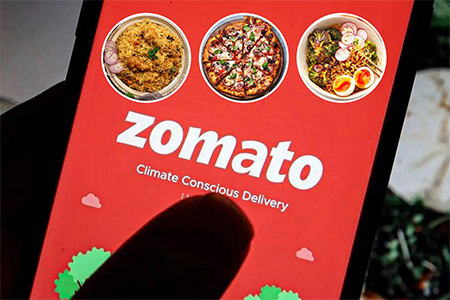
Amul’s topical ads
Amul has become a perfect example of creativity, and offbeat advertising in India. The milk brand routinely draws upon happenings, sports, politics, and popular culture through its trendy, satirical billboards carrying the Amul girl. All the ads use humor and real time commentary to connect with audiences, pointing fingers at Amul products as well as society at large. This technique has rendered the advertisements of Amul catchy and extremely shareable. It has created a loyal base of customers who eagerly await the brand's interpretation of the latest events.
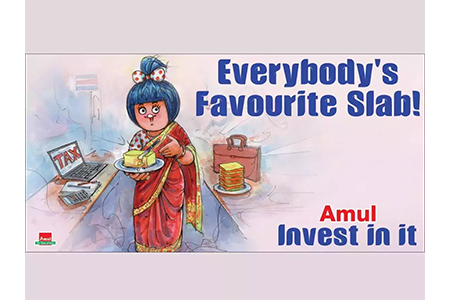
Non traditional advertising Cost
Perhaps the greatest draw of non traditional advertising is its affordability. Traditional forms such as TV advertising and newspaper advertisements tend to involve a significant expenditure of funds, but non traditional approaches may cost significantly less. For instance, guerrilla marketing uses ingenuity instead of big production expenses and is thus open to even smaller companies. Likewise, influencer marketing presents scalable solutions where brands can work with micro influencers or niche figures to produce targeted campaigns at a low cost. Experiential marketing, while sometimes subjecting brands to huge logistical expenses for event productions, usually yields good returns on the engagement and brand loyalty fronts. With social media marketing, brands can produce viral content at a low cost, usually depending on organic sharing as opposed to paid placement. The low entry cost and high ROI possibility make non traditional advertising an extremely appealing choice for businesses wishing to get the most out of their marketing rupees.
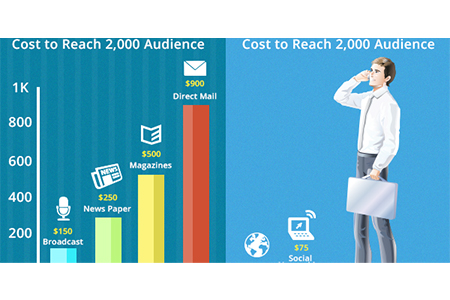
Challenges of non traditional advertising
While non traditional advertising offers great potential, it also comes with its challenges. Perhaps the greatest risk is the uncertainty of success. While traditional ads have more defined metrics, non traditional approaches can be tricky to monitor and quantify, making it more challenging to accurately assess their value. And as increasing numbers of brands turn to non traditional approaches, oversaturation enters the picture, with consumers growing boredom from too much change. The other risk is reputation risk, if an unorthodox campaign fails, it can rapidly turn into a PR disaster. Also, most of these campaigns are highly dependent on creative, timely, and relevant content, which may be hard to generate regularly. To counter these risks, brands need to keep innovating, monitor audience feedback, and maintain a crisis management plan. Testing smaller scale campaigns before full implementation and leveraging data analytics can also assist brands in maximizing their potential for success.
Non Traditional Advertising Strategies
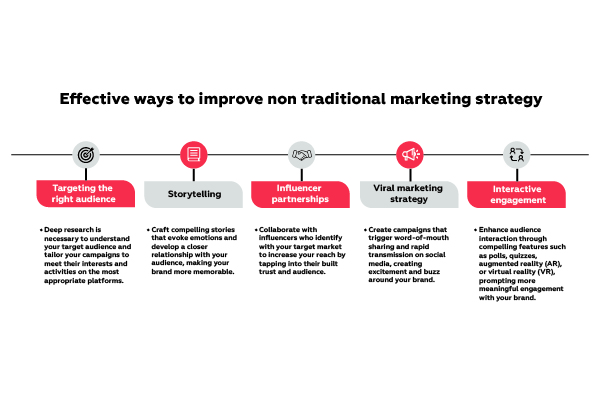
Conclusion
With the highly competitive marketplace today, non-traditional advertising has become a vibrant and effective means by which brands can engage and communicate with their public. Advertising agencies play a crucial role in this space by tapping into the power of creativity and leveraging true, engaging experiences to help businesses penetrate through the loud noise and make enduring, emotional connections with their customers. Through guerrilla marketing, influencer partnerships, or viral social media marketing, advertising agencies offer brands new means to remain relevant and be noticed. Despite the drawbacks of uncertainty and overexposure, the advantages of increased engagement, affordability, and greater customer connection make non-traditional advertising an essential tool for contemporary marketing plans. As the online environment continues to develop, advertising agencies that embrace these innovative strategies will be a force to be reckoned with, helping brands stand out and make a lasting impact.


